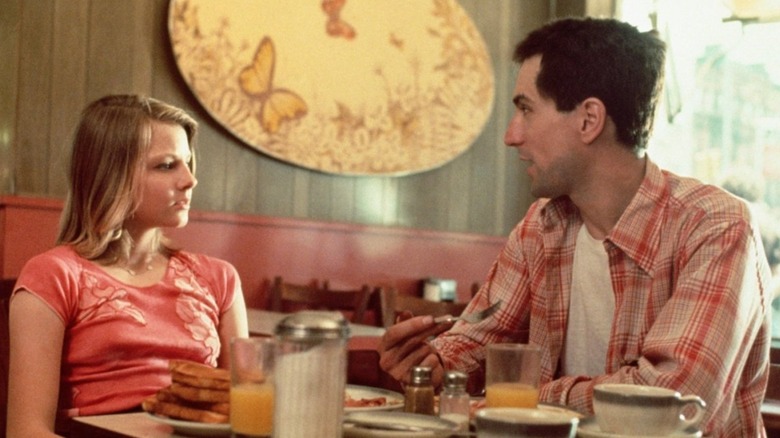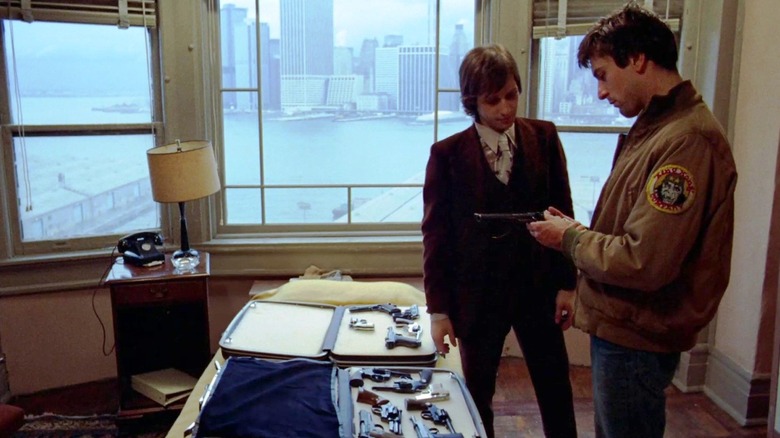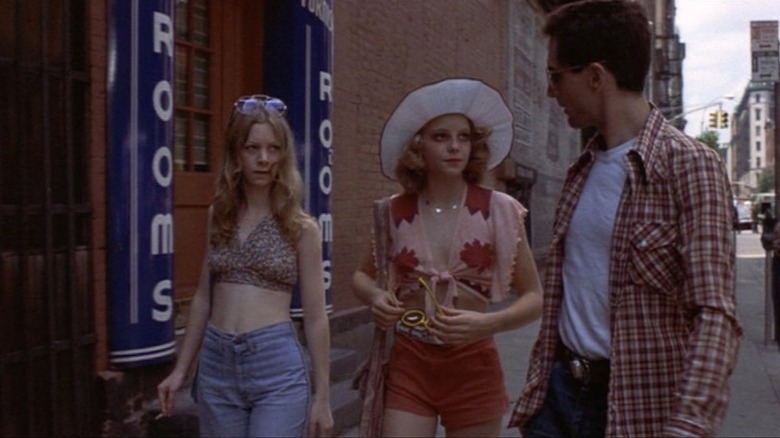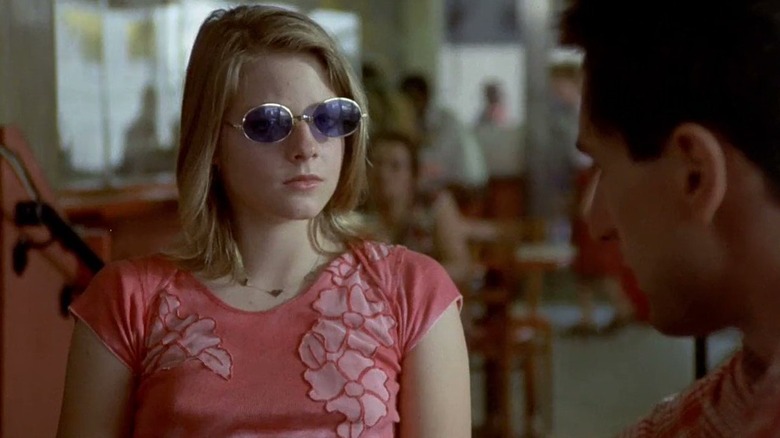Jodie Foster's Taxi Driver Experience With Robert De Niro Was Super Awkward
For as much as Martin Scorsese's 1976 classic "Taxi Driver" pushes you directly into the darkest parts of the human experience, few things are as disturbing as the character of preteen sex worker Iris (Jodie Foster). Travis Bickle (Robert De Niro), the titular driver, spots her early on in a haunting glimpse from the taxi window, just one horrifying part of the movie's grim and grimy texture. But in the movie's second half, we get to know her better, as Travis devotes his violent energy and obsessiveness to the mission of her rescue, knowing (and maybe even hoping) he will likely die as a result.
Because of Iris's complex and deeply sad situation, there was a great deal of sensitivity involved in bringing the character to life. Foster was just 12 years old when cast in the film, and the character of Iris was a far cry from the typical expectations of a child star. Foster had demonstrated clear talent in that arena, dominating commercials and Disney movies like 1972's "Napoleon and Samantha," but none of that work warranted a psychological evaluation beforehand. According to AFI, Foster's casting in "Taxi Driver" required it.
But most significant to Foster's electric, shocking work in the film was working with her scene partner Robert De Niro, one of the all-time great American actors. Iris is the opposite of Travis in a lot of ways — where he's brooding and intensely fixating on one thing or another, she is very much a child, seemingly totally unaware of what she's fallen into. To build that relationship and dichotomy out, De Niro collaborated with Foster, teaching her a fair bit about what acting was along the way. Which would get pretty awkward.
Scorsese's sense of realism
Midway through Travis's spiritual descent in the film, he ends up in a hotel room with Iris at the behest of her pimp Sport (Harvey Keitel). After pointedly rejecting her advances, he ends up going to a diner with her, where she ends up pouring nearly a dozen sugar packets into her coffee, a point that underlines both her age and her similarity to the junk food-eating Travis.
According to an oral history by The Hollywood Reporter, that detail about the coffee came from screenwriter Paul Schrader's hanging out in New York and meeting a strung-out teenage "working girl" named Garth Avery (who was unnervingly like the character he'd written). The detail immediately got added to the movie, which was something director Martin Scorsese has always done: fold as much reality into the context of a fictional construct as possible.
Even before "Taxi Driver," Scorsese made a point of bringing in such real details to his movies. His first feature, 1969's "Who's That Knocking At My Door," was semi-autobiographical. For its spiritual sequel "Mean Streets," in which Robert De Niro's casting came at the urging of lead Harvey Keitel, he incorporated fake home movies in the opening credits and cast his mother. As a filmmaker, he's always fused a vivid cinematic language with a sense of the natural elements of his characters' lives.
Both Scorsese and frequent collaborator Robert De Niro have regularly taken pains to do extensive research and build some verisimilitude into their work. A child star, even one as innately talented as Jodie Foster, playing a complex, disturbing role in a vigilante thriller like "Taxi Driver" necessitated some additional preparation.
Jodie Foster, child star
Most of Jodie Foster's work before "Taxi Driver" didn't ask much of the then-young actor. Whether it was her work in children's films or even Martin Scorsese's previous movie "Alice Doesn't Live Here Anymore" (where she played a street-smart kid teaching the titular character's son about the ways of the world), she could mostly just play herself. And, as she told The Hollywood Reporter, that was what she anticipated when she was cast in "Taxi Driver."
One of the reasons Robert De Niro had immediately established himself as an actor to watch in the 1970s was his intense commitment to his parts, particularly his role in Scorsese's 1973 film "Mean Streets." There, De Niro was a fireball, destroying relationships and the whole social order of his Little Italy neighborhood with a grin. For 1974's "The Godfather," he won the Oscar for Best Supporting Actor. And before production had begun on "Taxi Driver," he took shifts as a cabbie to get a feel for the energy he would need.
Needless to say, the combination of a child star and an unusually intense method-y actor could have been tough for the movie. Foster had a hard time with Iris's costumes. As she told THR, her mother tried to dissuade Scorsese from casting her. It could have been easy for her to lean into performance tics or to play a similar character to what she'd done in "Alice," and De Niro's unnerving characterization could have failed to mesh with it.
But they play their scenes together wonderfully, part of which could be owed to De Niro's effort to get to know his young co-star.
De Niro and Foster's diner outings
The actors went to a diner, just like their cinematic counterparts, and it was a little awkward. Just like their scenes in the movie.
Jodie Foster was used to projects that required her to read lines and bring an interesting energy, but this project would be different, and these diner meetings proved why. For Robert De Niro, these outings with Jodie Foster served a dual purpose. On one hand, it was a way for him to further develop Travis in a more nuanced and realistic way. But on the other, he was able to demonstrate to the young actor what building character entailed. For her, it was just "boring" as "he was pretty socially awkward then."
"I realized it was creating a character from scratch," Foster told THR, "which I'd never done before." In those meetings, De Niro went over the script with her exhaustively, largely in character. De Niro might have been awkward, but part of the divide between them came from the fact that he was creating Travis while she was still just playing herself. However, something "eye-opening" happened to Foster in the process. She began to understand improvisation, and the idea of "building a character in a way that was almost nonverbal."
For all of the hype around "Taxi Driver," its various controversies, or its legendary status, so much of the movie's greatness comes down to the unassuming dynamic between Travis and Iris. The scenes they share might lack the bloodshed or the intensity for which the movie is best known, but they have a sense of reality that makes them all the more unsettling. That might not have been the case if not for the foundation laid by the actors' preparation.



